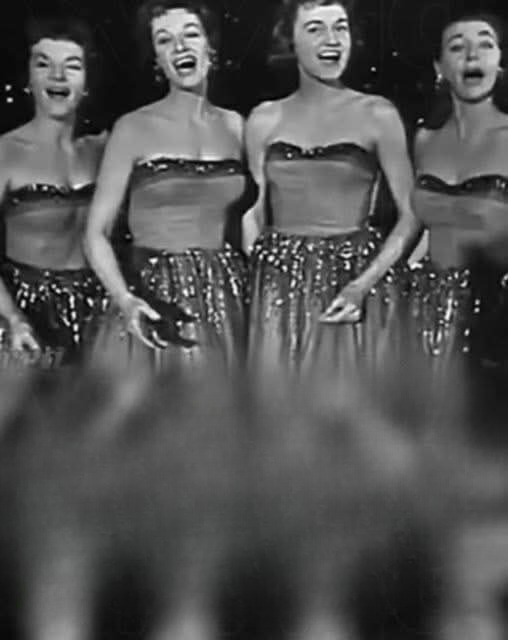Echoes of Harmony: Remembering The Chordettes and the Timeless Magic of “Mr. Sandman”
Posted on ByadminNo Commentson Echoes of Harmony: Remembering The Chordettes and the Timeless Magic of “Mr. Sandman”
Close your eyes for a moment and imagine stepping back into 1958. The world was changing — America was basking in postwar optimism, television sets flickered in cozy living rooms, and radio waves carried the sounds of a new musical revolution. President Dwight D. Eisenhower was in the White House, cars gleamed with chrome finishes, and teenagers gathered around jukeboxes to play their favorite hits. It was a time when rock and roll began to redefine culture, yet within that energetic shift, a group of four women from Sheboygan, Wisconsin, brought something refreshingly different — a sound both pure and enchanting.
Their name was The Chordettes — Janet Ertel, Alice Buschmann, Lynn Evans, and Jinny Osborn — a quartet whose harmonies could melt even the hardest of hearts. They didn’t rely on electric guitars or flashy showmanship. Instead, their magic came from precision, grace, and an almost celestial blend of voices that perfectly captured the optimism and innocence of the 1950s. When they released their hit “Mr. Sandman,” they didn’t just give listeners a catchy tune; they gifted them a dream set to melody.
A New Sound for a New America
In the late 1950s, popular music was dominated by bold new icons — Elvis Presley, Chuck Berry, Little Richard — artists who brought youthful energy and rhythm to mainstream audiences. But not everyone wanted to dance fast or live loud. Many longed for music that reminded them of love letters, starlit evenings, and the sweet simplicity of small-town life. That’s where The Chordettes found their niche.
The group had formed years earlier, initially inspired by barbershop quartets — a distinctly American musical tradition known for its close harmonies and a cappella style. But The Chordettes brought something different to the table: femininity, charm, and a delicate balance of voices that was both precise and soothing. When they sang together, it was as if one voice had been divided into four — each part essential, yet perfectly blended.
Their first big breakthrough came with “Mr. Sandman,” released in 1954. The song quickly became a sensation, reaching audiences far and wide. Its lyrics were playful, almost whimsical — a young woman’s lighthearted plea to the mythical Sandman to “bring her a dream” and send her the perfect love. But beneath the charm was something deeper: a reflection of hope, longing, and the universal wish for connection.
The Magic Behind the Melody
The genius of “Mr. Sandman” wasn’t just in its catchy rhythm or cheerful tone. It was in the technical mastery of The Chordettes’ performance. Each “bum-bum-bum” that listeners remember so fondly wasn’t a random note — it was a carefully orchestrated sequence, with each singer contributing one sound in quick succession. The result was a rhythmic bounce that made the song feel alive, as if it had a heartbeat of its own.
In live performances, The Chordettes were a vision of elegance. Dressed in coordinated gowns and standing side by side, they exuded both confidence and poise. Their choreography was simple but purposeful — a gentle sway, a synchronized glance, a tilt of the head in perfect unison. Nothing about their presentation was forced or exaggerated. It was authentic — a reflection of an era when entertainment was about grace, not spectacle.
Television had just begun to shape popular culture, and The Chordettes became regulars on programs like The Arthur Godfrey Show and Your Hit Parade. Their televised performances were more than just music; they were a cultural moment. In a time before digital filters and special effects, their harmonies and charm were all they needed to captivate millions.
“Mr. Sandman” and the Birth of Nostalgia
Listening to “Mr. Sandman” today, decades later, still stirs something inside. Its melody has that rare quality of being instantly recognizable — one note and the memories begin to flow. For those who lived through the 1950s, it recalls a gentler time: milkshakes shared at diners, first dates under neon lights, and dreams of futures filled with promise. For younger generations, it offers a glimpse into a world that seems almost magical in its simplicity.
Nostalgia is powerful. It’s not just about remembering; it’s about feeling again — reliving moments through sound, scent, and emotion. “Mr. Sandman” embodies that perfectly. It’s a reminder that music isn’t just entertainment — it’s a time machine that can transport us to places we thought were lost.
The Chordettes’ Signature Style
What made The Chordettes truly unique was their commitment to purity in sound. Unlike many of their contemporaries, they often performed without heavy instrumentation, relying instead on their vocal interplay. Each member had a distinct voice, yet together they created something seamless. Their harmonies were so tight that you could almost visualize the sound waves intertwining in perfect alignment.
Their repertoire expanded beyond “Mr. Sandman.” Songs like “Lollipop,” with its irresistible “pop-pop” refrain, showcased their playful side. The tune became an anthem for cheerful innocence, featured in countless movies, commercials, and nostalgic TV moments. “Born to Be with You,” another hit, displayed their emotional depth, proving they could move listeners not just to smiles but to tears.
Even as musical tastes evolved — as rock, soul, and later disco took over — The Chordettes’ music continued to find new audiences. Their songs appeared in films, retro compilations, and advertisements, introducing new generations to the golden harmonies of the 1950s.
A Legacy Beyond Time
It’s easy to forget just how influential The Chordettes were. They were pioneers for women in a male-dominated industry, proving that female artists could succeed on their own terms. Long before girl groups like The Supremes or The Ronettes graced the charts, The Chordettes were laying the foundation — not through rebellion or defiance, but through excellence.
Their image was wholesome, yet it carried quiet strength. They represented grace under pressure, artistry over flash, and the belief that music should touch the heart. In that way, they became icons — not only of their time but of timeless artistry itself.
Decades after their debut, their influence can still be felt. Contemporary a cappella groups, from Pentatonix to university choirs, often cite early quartets like The Chordettes as inspirations. Even in modern pop production, you can hear echoes of their harmonies — that bright, layered vocal texture that defined mid-century sound.
Why “Mr. Sandman” Still Matters
There’s a reason why “Mr. Sandman” continues to appear in movies, television shows, and online trends. Its charm lies in its universality. Everyone, regardless of age, can relate to its message: the desire for love, the hope for dreams, and the simple joy of melody.
The song has been featured in everything from Back to the Future to Stranger Things, bridging generations through shared nostalgia. Each time it plays, it connects people — grandparents remembering their youth, parents recalling family road trips, and young listeners discovering it for the first time through social media.
In an age where technology changes faster than memory can keep up, songs like “Mr. Sandman” remind us that beauty doesn’t need to be complicated. Sometimes, all it takes is four voices, one microphone, and a melody that makes the world feel gentle again.
Hearing It Again — A Personal Reflection
Hearing “Mr. Sandman” today is like opening a time capsule. The first few notes sparkle like morning sunlight, and suddenly, you’re there — in a black-and-white world where everything feels new. You can almost see the vintage cars gliding down main streets, the soda fountains buzzing with chatter, the teenagers dancing in sock hops, and the radio glowing softly in the corner of a living room.
For many, the song is more than a tune; it’s a connection to loved ones — parents who sang along in their youth, or grandparents who shared their stories of the 1950s. It evokes the tenderness of memory, reminding us how music can outlast generations, weaving emotions across time.
The Enduring Power of Simplicity
The Chordettes’ success story also serves as a reminder of something rare in today’s fast-paced world: the beauty of simplicity. There were no elaborate stage lights, no digital enhancements, no autotune. What you heard was real — a product of talent, practice, and passion.
In an era flooded with noise, their music still feels like a quiet refuge. It invites listeners to slow down, to breathe, and to remember that artistry doesn’t always need to shout to be heard. The Chordettes achieved what every musician dreams of — to create something that transcends time.
A Dream That Never Fades
As the years pass, and as generations come and go, certain melodies never fade. “Mr. Sandman” is one of them. It’s been covered by countless artists, remixed, and reimagined, yet the original remains unmatched — a blend of innocence and mastery that no modern version can quite replicate.
Even today, vinyl collectors search for original pressings, and online communities celebrate the group’s legacy. You can find videos of The Chordettes performing live — their synchronized movements, sparkling smiles, and effortless delivery. Watch them for even a minute, and you’ll understand why the world fell in love with them.
Theirs was an era defined by optimism. People believed in the future, in family, in music that made you feel good. “Mr. Sandman” captured that perfectly — a song not about heartbreak or rebellion, but about joy, hope, and imagination.
The Gift of Musical Memory
Music has a unique way of preserving moments. It’s like a photograph for the soul — every note, every lyric tied to emotion. When you hear “Mr. Sandman” today, you’re not just listening to a song; you’re reliving an entire chapter of cultural history. You’re hearing the laughter of audiences watching black-and-white TV, the echoes of teenage dreams, and the heartbeat of a nation finding its rhythm.
That’s what makes The Chordettes special. They weren’t just singers; they were storytellers of sound. Their harmonies told tales of love and longing without needing complex words or heavy emotion. Their music was joy in its purest form.
A Legacy Written in Melody
Over sixty years later, the world has changed in countless ways. But when “Mr. Sandman” begins to play, time stands still. The laughter, the love, and the light of the 1950s return for a few precious minutes. It’s proof that art endures — that something made with sincerity and heart will always find new life.
The Chordettes began as four women harmonizing in a small Wisconsin town. They probably never imagined that their voices would one day echo across decades, touching millions. But they did. They left behind more than songs — they left behind a feeling, a sense of wonder that no era can erase.
So the next time you hear that familiar intro — those sparkling notes that open “Mr. Sandman” — take a moment to listen closely. Let it transport you. Let it remind you of a world filled with hope, elegance, and melody. Because some dreams, like the ones sung by The Chordettes, never truly end.
Conclusion: Music That Lives Forever
“They Sang THIS Hit in 1958 — And Hearing It 60 Years Later Floods Me with Memories” isn’t just a reflection of nostalgia; it’s a tribute to timeless artistry. The Chordettes’ “Mr. Sandman” is more than a relic of the past — it’s a living memory, passed from generation to generation.
It continues to enchant, inspire, and remind us that even in a world of constant change, some melodies are eternal. The laughter and love woven into their harmonies remain as vibrant as ever. And that’s the greatest testament any artist can hope for — to create something that outlives them, resonating forever in the hearts of those who listen.
Because, in the end, it’s not just a song — it’s a dream that keeps on singing.

